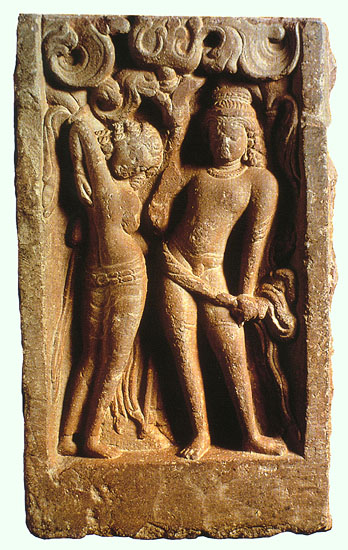<< previous image || Desire & Devotion || next image>>

Amorous Couple
India (Madhya Pradesh), ca. 500
Pink sandstone, 15 1/2 in (39.4 cm)
Published: Freschi 1998, pp. 16-17
Catalogue #3
|
Amorous couples, known in Sanskrit generally as mithuna (meaning couple as well as the act of coupling), are an integral part of temple decoration. A symbol of auspiciousness and fertility, such couples are frequently included on either side of the entrance to a shrine. This particular example once formed the bottom part of the jamb of a Gupta-period temple. The couple in this panel is not simply of a generic type but makes a more specific statement. The somewhat aloof male stands in a leisurely fashion in the hipshot position. His left hand clasps the thick sash that crosses his thighs diagonally. The broken right hand would have formed the gesture of reassurance. While this is not the attitude one expects in an eager lover, it may be understood in light of the correct interpretation of the female's posture. Unlike most such representations of couples, she is detached from the male and, in fact, assumes a contorted position, with her back to the viewer and her head turned in three-quarter profile. She cups a breast with her left hand and raises her right arm awkwardly to draw her lover's, as well as the spectator's, attention to the scalloped marks behind her breast. These are clearly nail marks made by her ardent lover during lovemaking. Perhaps they have just consummated their love in an arbor, represented by the swirling, stylized foliage alcove that is suggestive of passionate desires. Such marks left by lovers are considered as telltale evidence of voluptuous lovemaking in Indian texts on erotics, as seen in the verse below. Apart from the lively interaction of the two figures, the composition is animated by the lady's posture, the swinging sashes and scarves, and the luxuriantly curling and deeply cut foliage. While the exact provenance of such isolated sculptures is difficult to determine, very likely it is from Madhya Pradesh. The closest stylistic parallels, both in the suave modeling of the figures and their lissome grace, may be seen in several temples of the fifth-sixth centuries, such as the Parvati Temple at Nachna (Williams 1982, figs. 151 and 154). What are golden ornaments, Detail: close-up of face all
text and images © The Trustees of the Walters Art Gallery, Baltimore
|
<< previous image || Desire & Devotion || next image>>
